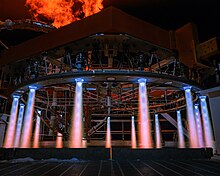Stoke Space
| Company type | Private |
|---|---|
| Industry | Space |
| Founded | 2020 |
| Founders | Andy Lapsa, Tom Feldman |
| Headquarters | |
Number of employees | 100 |
| Website | https://www.stokespace.com/ |
Stoke Space Technologies is an American space launch company based in the Seattle suburb of Kent, Washington.
History[edit]
The company was founded by a group of former Blue Origin and SpaceX employees.[1] In May 2020, the company won a $225,000 SBIR Phase I grant from the National Science Foundation to work on an integrated propulsion solution for reusable rocket upper stages.[2] In February 2021, the company raised $9.1 million in seed funding in a round led by venture funds NFX and MaC Venture Capital.[1] In December 2021, the company raised $65 million in a Series A round led by Breakthrough Energy Ventures,[3] funding development and testing of the upper stage of a reusable launch vehicle.[4]
In 2022, the company created a prototype of their second stage engine ring. Their prototype had at least 22 static fires in total.

In 2023, Stoke Space had an interview with Tim Dodd (also known as The Everyday Astronaut), wherein the CEO Andy Lapsa revealed their plan to create a fully and rapidly reusable orbital rocket.[5]
In the first months of 2023, Stoke Space finished the construction of Hopper1, a full-scale second stage prototype, intended to test fluid mechanics in the vehicle. On March 8, 2023, the company was given LC-14 in Florida as a future launch pad for their vehicles.[6] On March 18, Stoke Space's second stage conducted a Wet Dress Rehearsal, where the company loaded both Liquid Oxygen (LOX) and Liquid Hydrogen into the stage's tanks, preparing it for launch without igniting the engines.[7]
On September 17, 2023, Stoke Space conducted a 10 meter "hop" test of "Hopper2", testing their unique differential steering method.

In 15 seconds, the vehicle ignited its 15 thrust chambers (half of the amount used on the operational vehicle), lifted 30 feet off the ground, showed its ability to steer without gimballing the engine like traditional rockets, and tested the actively cooled heatshield before successfully landing under three landing struts.[8] In October 2023, Stoke Space announced a $100 million Series B funding round led by Industrious Ventures.[9]
In April 2024, the company announced it had completed assembly and installation of a first stage engine for test firing.[10]
Facilities[edit]
The company operates a rocket test facility on a 75-acre (30 ha) site near Moses Lake's airport.[11]
Technology[edit]
Stoke Space is developing a fully and rapidly reusable space launch vehicle called Nova,[12] and is focusing on its second stage. Stoke Space's reusable second-stage uses a single engine with 30 thrust chambers around the circumference of the vehicle, along with a center passive bleed to create an aerospike engine-like effect. Additionally, the center bleed acts as a heat shield during re-entry, eliminating the need for brittle ceramic tiles that have required detailed inspections and lengthy refurbishments on other space vehicles,[13][14] like the Space Shuttle orbiter. For its reusable first stage, the company is considering 7 conventional full-flow-staged combustion rocket engines, burning methalox. This configuration is very similar to SpaceX's Raptor Engine.[15][16]
References[edit]
- ^ a b "Stoke raises seed round to work on fully reusable rockets". February 25, 2021.
- ^ "Relativity and Reach, Stoke and Starfish: Blue Origin veterans spark space startups". September 10, 2020.
- ^ "Rocket Report: SpaceX plans a Falcon 9 flurry, Bill Gates buys into rockets". December 17, 2021.
- ^ "Stoke Space raises $65 million for reusable launch vehicle development". December 15, 2021.
- ^ Sesnic, Trevor (February 4, 2023). "Full Reusability By Stoke Space". Everyday Astronaut. Retrieved March 27, 2023.
- ^ Boyle, Alan (March 8, 2023). "Godspeed, Stoke Space! Rocket startup gets John Glenn's launch pad at the Cape". GeekWire. Retrieved September 20, 2023.
- ^ Bradbury, Brent (August 23, 2023). "Stoke Space's Next Development Test Series: Hopper2". Stoke Space / 100% reusable rockets / USA. Retrieved March 20, 2024.
- ^ Bradbury, Brent (September 18, 2023). "Update on Hopper2: The Hopper Has Landed". Stoke Space / 100% reusable rockets / USA. Retrieved September 20, 2023.
- ^ Foust, Jeff (October 6, 2023). "Stoke Space raises $100 million for reusable rocket development". SpaceNews. Retrieved October 10, 2023.
- ^ "Stage 1 engine assembly, checkout, shipping, install complete".
- ^ "Bill Gates' Breakthrough Energy leads $65M funding round for Stoke Space's reusable rockets". December 15, 2021.
- ^ Davis, Anthony (October 5, 2023). "Stoke Space Announces $100 Million in New Investment". Stoke Space / 100% reusable rockets / USA. Retrieved October 5, 2023.
- ^ "STOKE Space Raises $65M Series a to Make Space Access Sustainable and Scalable" (Press release). December 15, 2021.
- ^ Volosín, Trevor Sesnic, Juan I. Morales (February 4, 2023). "Full Reusability By Stoke Space". Everyday Astronaut. Retrieved February 5, 2023.
{{cite web}}: CS1 maint: multiple names: authors list (link) - ^ "Rocket". www.stokespace.com. Retrieved July 28, 2023.
- ^ Ralph, Eric (February 8, 2023). "Stoke Space to build SpaceX Raptor engine's first real competitor". TESLARATI. Retrieved September 20, 2023.
Further reading[edit]
- How Stoke Space's Unique Rocket Works, Exclusive Tour & Interview on YouTube
- Stoke Space CEO Andy Lapsa - Fully Reusable Rockets - NSF Live on YouTube
External links[edit]
- Official website: https://www.stokespace.com
